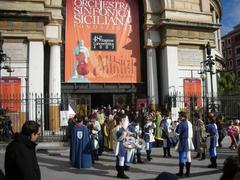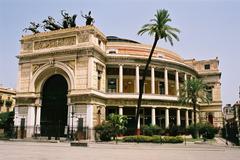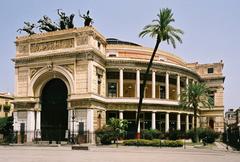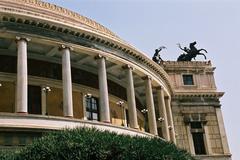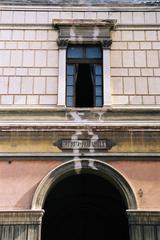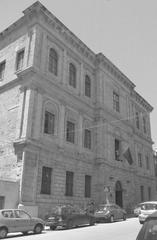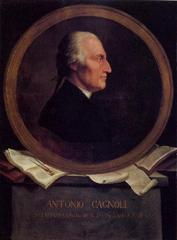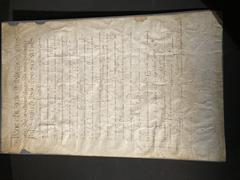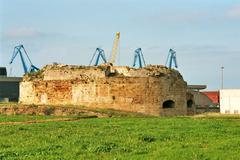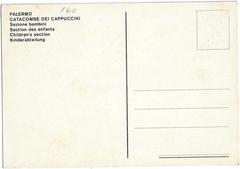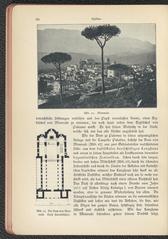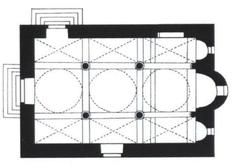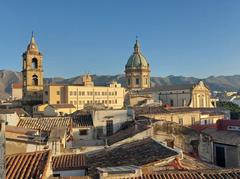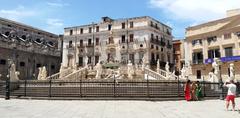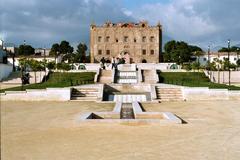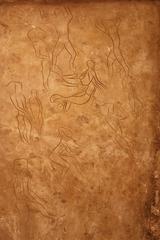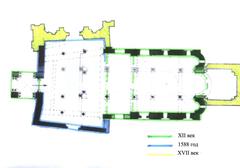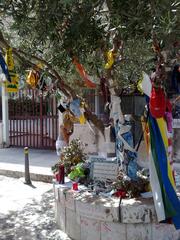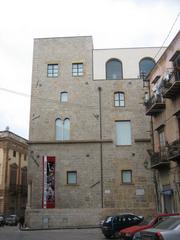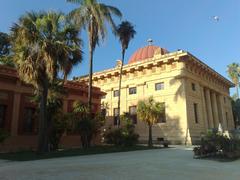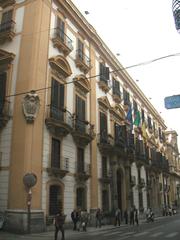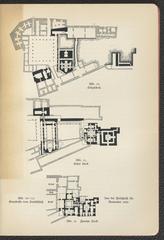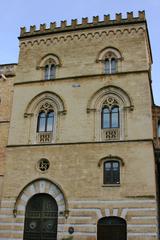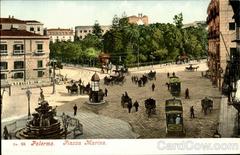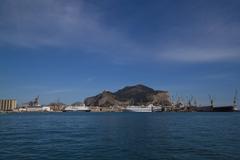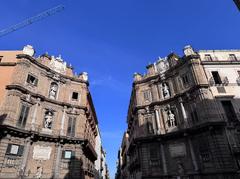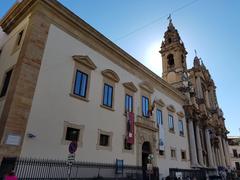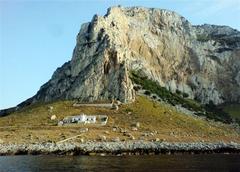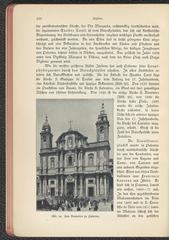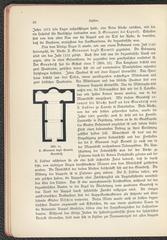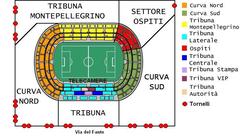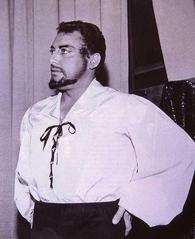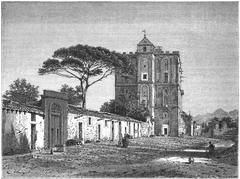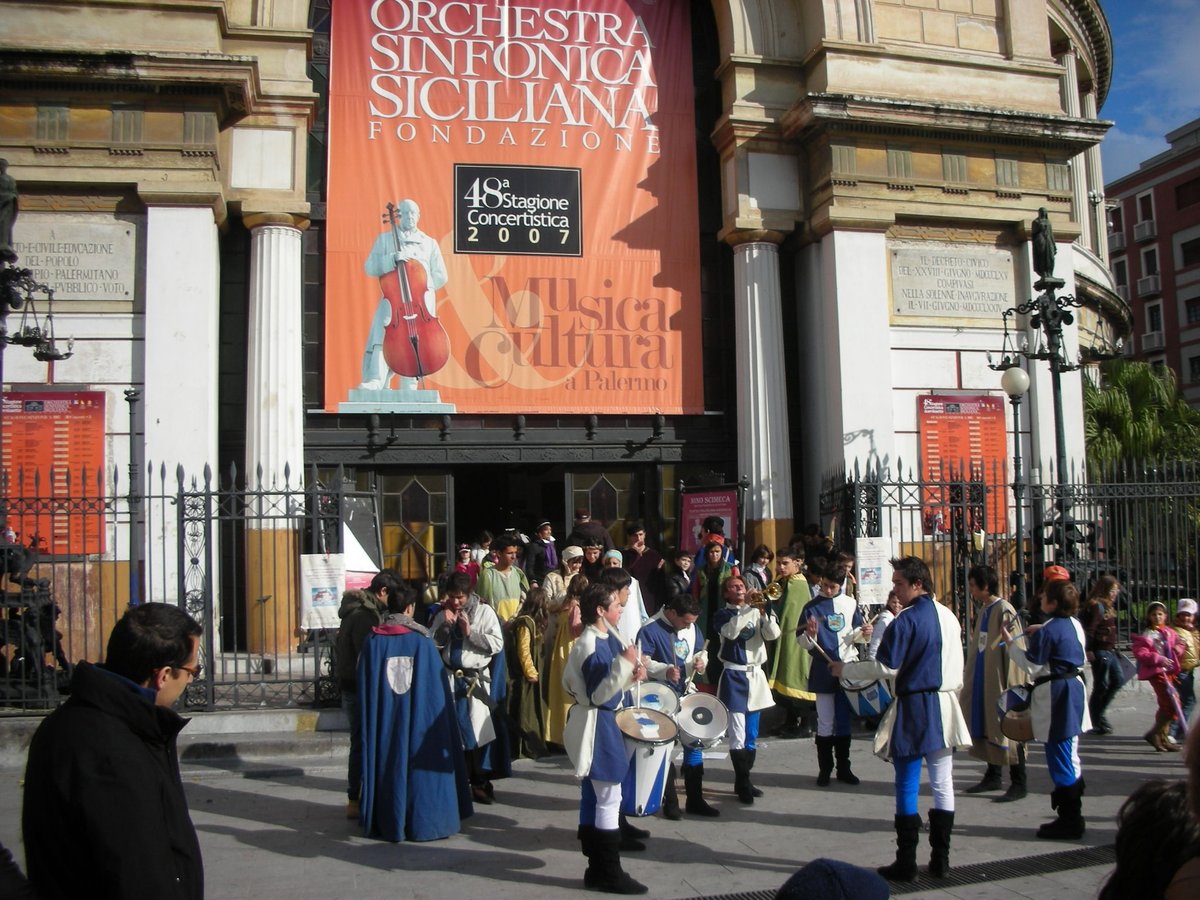
Teatro Politeama Palermo: Visiting Hours, Tickets, and In-Depth Historical Guide
Date: 15/06/2025
Introduction
The Teatro Politeama Garibaldi, located in the vibrant heart of Palermo, is a striking symbol of the city’s artistic spirit and 19th-century urban transformation. Designed by Giuseppe Damiani Almeyda in 1867, this neoclassical landmark embodies Palermo’s aspirations for cultural inclusivity and civic pride following Italian unification. Today, the theater is celebrated not only for its architectural innovations—including the iconic bronze quadriga and iron-and-glass dome—but also as a dynamic cultural hub, home to the Orchestra Sinfonica Siciliana and a rich calendar of performances and community events. This comprehensive guide explores the theater’s history, architecture, visitor information, and practical tips to help you plan a memorable visit.
Table of Contents
- Introduction
- Historical Context and Origins
- Architectural Significance
- Cultural Role and Evolution
- Planning Your Visit
- Nearby Attractions
- Restoration and Preservation Efforts
- Visitor Tips and Practical Information
- Frequently Asked Questions (FAQ)
- Conclusion
- References and Further Reading
Historical Context and Origins
Teatro Politeama Garibaldi was conceived during a period of revitalization in Palermo, following the city’s struggles with social and economic upheaval in the late 1860s. The ambition was to create a “politeama”—an inclusive venue for a variety of performances, accessible to all social classes, and set in a modern urban context. Almeyda’s commission in 1867 led to the theater’s strategic placement in Piazza Ruggero Settimo, reflecting Palermo’s aspiration to join the ranks of Europe’s cosmopolitan capitals and to foster civic unity (carapalermo.com; palermoerasmuslife.net).
Architectural Significance
Exterior and Façade Highlights
The Politeama’s neoclassical façade is instantly recognizable, dominated by a monumental triumphal arch surmounted by Mario Rutelli’s bronze quadriga depicting Apollo and Euterpe, symbolizing the triumph of the arts (The World of Sicily). Flanking the arch are dynamic horse statues by Benedetto Civiletti. The façade features rows of Doric and Ionic columns surrounding a semi-circular plan, echoing ancient Greek and Roman models and fostering a sense of openness and accessibility (Understanding Italy).
The exterior walls are decorated in Pompeian style, with motifs referencing the Olympic Games and horse racing—reflecting the theater’s original multifunctional purpose (The World of Sicily).
A distinctive feature is the iron-and-glass dome, crafted in 1877 by Fonderia Oretea. This engineering marvel allows natural light to fill the auditorium, a rarity among theaters of its era (The World of Sicily).
Interior Layout and Decorative Features
Inside, Teatro Politeama boasts a grand horseshoe-shaped auditorium originally designed to seat nearly 5,000 spectators (current capacity: ~950). The auditorium includes two tiers of private boxes, a double gallery, and a central proscenium marked by a hexastyle Corinthian colonnade and a bronze bust of Garibaldi (Palermo NCC).
The dome’s interior is painted sky blue, with a pictorial cycle by Gustavo Mancinelli at its base, illustrating the Feste Eleuterie. Mancinelli’s masterpiece main curtain, depicting “Aeschylus at the Court of Hieron of Syracuse,” further heightens the interior’s artistic grandeur. Gilded stuccoes, velvet seats, and elegant woodwork harmonize luxury with accessibility (Palermo NCC).
Structural and Artistic Innovations
The theater’s construction exemplifies 19th-century technological progress, with iron and glass used extensively in the dome and supporting structures. This approach allowed for a wide, unobstructed span above the auditorium and enhanced both acoustics and illumination (The World of Sicily). Artistic symbolism abounds, from the triumphal quadriga to friezes celebrating athleticism and festivity—reinforcing the theater’s civic and inclusive mission (Italia Guides).
Cultural Role and Evolution
Early Years and Inauguration
Teatro Politeama opened in 1874 with Bellini’s “I Capuleti e i Montecchi,” even before completion, marking the city’s cultural rebirth and serving as a key venue for operas, concerts, circus acts, and public celebrations (carapalermo.com).
Multifunctional Use and Modern Programming
True to its “polytheama” name, the theater has hosted a vast range of events—from equestrian shows and festivals to world-class symphonic concerts. It became a popular cinema in the mid-20th century and, since 2001, has been the permanent home of the Orchestra Sinfonica Siciliana (teatro.it; Orchestra Sinfonica Siciliana). The Politeama’s programming now includes classical and contemporary music, opera, ballet, and international festivals such as “Palermo Classica” (Great Sicily).
Planning Your Visit
Visiting Hours
- Standard Hours: Tuesday to Saturday, 10:00 AM – 6:00 PM
- Closed: Sundays and public holidays (unless otherwise announced for special events or performances)
- Performance Evenings: Ticket offices remain open into the evening
- Guided Tours: By appointment; check the official website for availability (Politeama.eu).
Ticket Information
- General Admission: €10–€50 (depending on event)
- Reduced Rates: €7 for students, seniors, and groups
- Guided Tours: ~€5 per person (Italian and English, approx. 45–50 minutes)
- Booking: Advance booking recommended; tickets available online, by phone, or at the box office (Orchestra Sinfonica Siciliana).
Accessibility and Getting There
- Location: Piazza Ruggero Settimo, Palermo
- Public Transport: Easily reachable by bus, tram, and taxi; parking nearby is limited (Bandsintown)
- Wheelchair Access: Ramps, elevators, and reserved seating are available; contact the theater in advance for special needs.
Guided Tours and Events
- Guided tours visit the foyer, grand auditorium, Sala Rossa, Sala Gialla, colonnades, central box, and the panoramic terrace
- Tours are led by expert guides, often including local legends and historical anecdotes (Sicilia Mare)
- Year-round programming includes opera, symphonic concerts, theater, and special festivals
Nearby Attractions
- Teatro Massimo: Palermo’s grand opera house (10-minute walk)
- Quattro Canti: Historic Baroque intersection
- Palermo Cathedral: Iconic religious and architectural site
- Via della Libertà: Upscale shopping and dining
- Other Cultural Venues: Teatro di Verdura, Teatro Santa Cecilia, Cinema Teatro Golden (Bandsintown)
Restoration and Preservation Efforts
A major €15 million restoration began in April 2025, addressing both structural and decorative elements to safeguard the theater’s heritage. The project includes façade cleaning, dome conservation, and restoration of interior artworks, ensuring the Politeama’s continued vitality as a cultural landmark (Il Fatto di Palermo).
Visitor Tips and Practical Information
- Arrive Early: Allow time for security checks and to appreciate the exterior architecture.
- Dress Code: Smart casual, especially for evening performances.
- Photography: Permitted in public areas during tours—confirm rules before photographing performances.
- Amenities: Modern restrooms, cloakroom (during events), and accessible seating
- Nearby Dining: Cafés and restaurants surround Piazza Ruggero Settimo (Trip.com)
- Climate: The theater is climate-controlled; summer visits are comfortable.
Frequently Asked Questions (FAQ)
Q: What are the visiting hours of Teatro Politeama Garibaldi?
A: Typically Tuesday to Saturday, 10:00 AM–6:00 PM. Extended hours for events. Always check the official website for updates.
Q: How do I buy tickets?
A: Purchase online via the official website, by phone, or at the box office.
Q: Are guided tours available in English?
A: Yes, tours are often available in both Italian and English. Book in advance.
Q: Is the theater accessible for visitors with disabilities?
A: Yes, with ramps, elevators, accessible restrooms, and reserved seating. Notify the theater for specific requirements.
Q: Are children welcome at performances?
A: Most events are family-friendly, though supervision is required in balconies.
Conclusion
Teatro Politeama Garibaldi is much more than a historic building; it is a living symbol of Palermo’s resilience, openness, and dedication to the arts. Its neoclassical grandeur, innovative dome, and vibrant programming offer a multifaceted experience for visitors. Whether you are drawn by history, architecture, or live performance, the Politeama provides a profound connection to Palermo’s cultural identity.
Plan your visit by checking current hours and booking tickets in advance. Download the Audiala app for exclusive guides and updates, and enrich your journey by exploring nearby landmarks in Palermo’s historic core.
References and Further Reading
- This is a sample text. (carapalermo.com)
- This is a sample text. (palermoerasmuslife.net)
- This is a sample text. (The World of Sicily)
- This is a sample text. (Eventi Siciliani)
- This is a sample text. (Sicilia Mare)
- This is a sample text. (teatro.it)
- This is a sample text. (Il Fatto di Palermo)
- This is a sample text. (Understanding Italy)
- This is a sample text. (Orchestra Sinfonica Siciliana)
- This is a sample text. (Bandsintown)
- This is a sample text. (Palermo NCC)
- This is a sample text. (Italia Guides)
- This is a sample text. (Trip.com)
- This is a sample text. (Politeama.eu)
- This is a sample text. (Scopri la Sicilia)
- This is a sample text. (Great Sicily)
